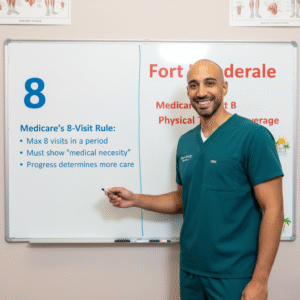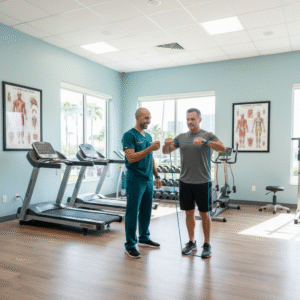Why This Question Matters
If you’re recovering from surgery, managing chronic pain, or coming back after an accident, you might hear both terms, physiotherapy and rehabilitation, in your treatment plan. While they’re related, they’re not the same.
Understanding the difference helps you set realistic expectations, ask the right questions, and build a recovery plan that truly fits your needs.
What Is Physiotherapy?
Physiotherapy (often called physical therapy in the US) is a specialized branch of healthcare focused on:
- Restoring movement and flexibility
- Strengthening muscles and joints
- Managing pain
- Preventing further injury
Physiotherapists use tools and techniques like:
- Manual therapy
- Therapeutic exercise
- Postural training
- Electrotherapy and ultrasound
The primary goal? Help you regain function and move confidently in daily life.
What Is Rehabilitation?
Rehabilitation is the broader process of recovery after injury, surgery, illness, or long-term health challenges.
It isn’t limited to physical function; it addresses the whole person, including:
- Physical recovery (physiotherapy)
- Occupational therapy (relearning daily tasks and work-related skills)
- Speech and language therapy
- Cognitive or psychological therapy
- Pain management strategies
- Social or vocational support
In other words, physiotherapy is often part of rehabilitation, but rehabilitation itself covers much more.
How Do They Work Together?
- Physiotherapy = Focuses on physical movement and function.
- Rehabilitation = Combines physical therapy with emotional, cognitive, and practical support to rebuild independence and quality of life.
For many patients, especially after major injuries or neurological conditions, a multidisciplinary rehabilitation plan delivers better, longer-lasting results than physiotherapy alone.
Why Knowing the Difference Helps Your Recovery
Understanding this difference allows you to:
Make informed choices about your care
Discuss broader needs beyond movement (like speech, mental health, or daily living skills)
Set realistic timelines and milestones for your recovery
Become an active participant in your healing
Patients who see recovery as more than physical movement often report higher satisfaction and better outcomes.
Key Takeaway
- Physiotherapy: A specialized treatment focused on restoring movement and physical strength.
- Rehabilitation: A holistic, team-based approach to help you regain independence across all aspects of life.
Both play vital roles, but together they create a stronger, more sustainable path back to health.
Conclusion
Physiotherapy and rehabilitation are closely connected, but they’re not interchangeable. Physiotherapy is a cornerstone of rehabilitation, but full rehabilitation looks beyond the body, supporting the mind, emotions, and day-to-day life.
Understanding this difference gives you clarity, control, and confidence as you move forward on your recovery journey.








